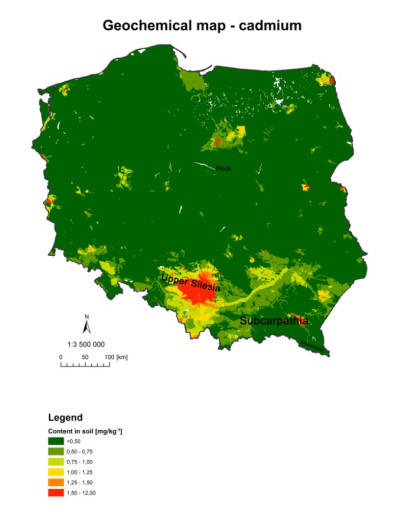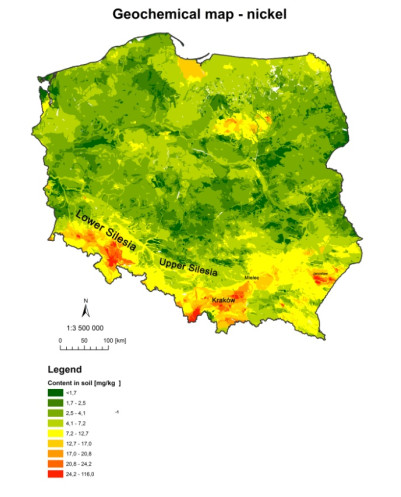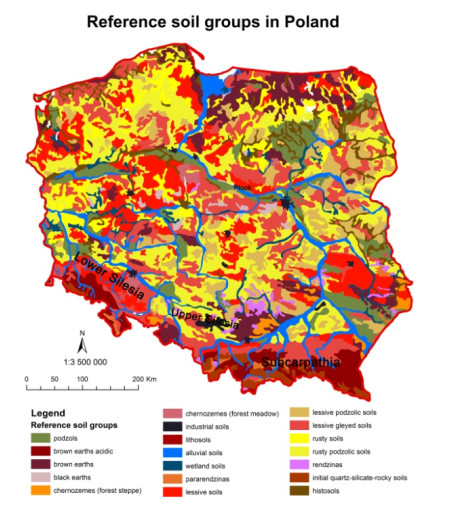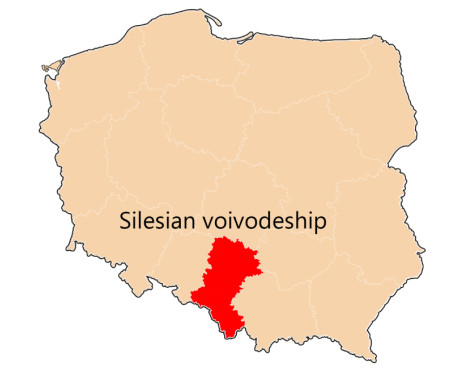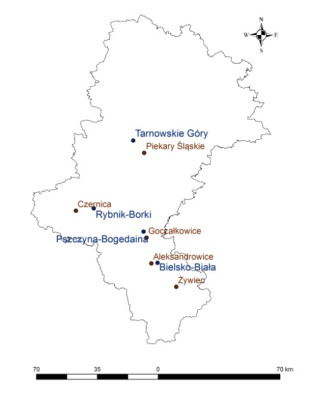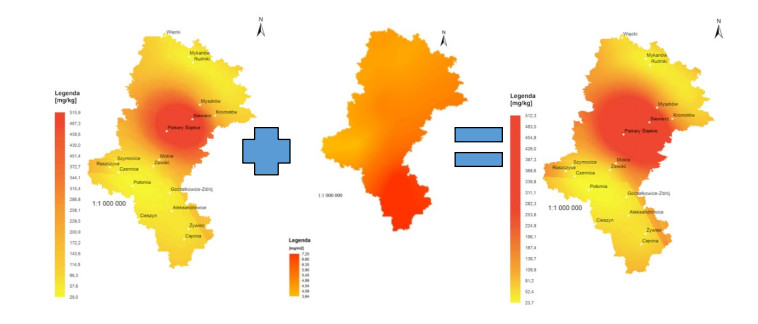The increasing number of spatial data sets permits their application for minimising the duration and cost of such research. An example of such application is geostatistical modelling. Data on the quality of atmospheric air can be used for the assessment of the quality of soil in a given area. The objective of the study was an attempt to apply geostatistical methods in the estimation of the degree of soil contamination with selected heavy metals resulting from deposition from atmospheric air. This paper uses data obtained from the State Environmental Monitoring (data on the quality of atmospheric air) and other collections of publicly available spatial data for the purpose of analysis of the state of quality of soils in the province of Silesia in Poland. Conducted analyses revealing that contamination with lead in atmospheric air in the Silesian voivodeship considerably exceeds acceptable values, and the load of lead deposition is largely transferred to the soil. The paper also presents geochemical maps necessary to understand sources of soil contamination, including their natural content.
1.
Introduction
Contamination of the environment among others with heavy metals considerably has increased over the last centuries as a result of rapid civilisation development, and particularly urbanisation and industrialisation [1]. Due to this, environmental management is an object of interest of scientists, authorities, and entities dealing with environmental protection [2]. Data concerning the spatial distribution of soil pollution with heavy metals are of great importance for the environmental protection, regional development, and spatial planning [3]. Owing to geostatistical and spatial information systems, commonly used in many areas of the economy, the majority of data from the existing resources can be presented with no loss of valuable information [4,5]. The application of geostatistics at the beginning have been reserved for the estimation of mineral and petroleum resources [6]. Recently geostatistics is used in oceanography, cartography, meteorology, agriculture, fisheries resources, civil engineering, finance, as well as the environment, especially in the contaminated sites [7,8,9,10,11]. The determination of the sources of anthropopressure requires the understanding of the spatial distribution of heavy metals in soils [10,11]. The approach based on the spatial information system is useful for the description of such structures [10,11]. Better understanding of the scale of soil pollution with heavy metals can be facilitated by geochemical cartography [11,12]. By means of maps, it presents the distribution of chemical elements in soils, bottom sediments, surface water, and groundwater [13,14]. It presents data which should be considered among the most important criteria in defining limitations of various anthropogenic activities [15]. Moreover, it is one of the most useful tools for the implementation of plans of environmental interventions [16,17]. Soil pollution with heavy metals is particularly strenuous in areas concentrating industry related to coal and liquid fuels extraction, mining and smelting industry, chemical industry, energy production, agriculture, and transport [11,18,19]. According to research conducted by the Polish Geological Institute-National Research Institute (PGI-NRI), soils in certain regions of Poland are strongly polluted with heavy metals particularly hazardous for human health and life, such as arsenic, cadmium, nickel, and lead, and the soil pollution persists considerably longer than air and water pollution—even up to several centuries.
Data concerning the content of heavy metals can be presented in the form of a cartographic study (map) resulting from their interpolation in a specific point. The first stage involves interpolation followed by agammaegation of values obtained as a result of interpolation, within designated geological segments. Agammaegation results in ascribing a designated geological segment with a mean or median of the content of an element (substance)—depending on the distribution of a given element [11,20].
The main aim of the study was the analysis of the content of selected heavy metals: arsenic, cadmium, nickel, and lead in soils in Poland, identification of degraded areas and the emitters of contamination, as well as the assessment of the degree of soil contamination with arsenic, cadmium, nickel, and lead. The specific aims of the work were to use geostatistical methods to estimate the degree of heavy metal soil pollution caused by dry and/or wet deposition from atmospheric air, to determine the relationship between the level of heavy metal pollution in atmospheric air and soils for the purposes of assessing their quality and determining the possibility of assessment damage to the soil environment in the province of Silesia in Poland.
2.
Materials and method
The maps were prepared based on Web Map Services (WMS) provided by the Polish Geological Institute-National Research Institute (PGI-NRI), with the application of GIS software. Maps of soil contamination with selected heavy metals: arsenic, cadmium, lead, and nickel, were prepared as a combination of the interpolation of their content in soils with the agammaegation of values within designated geological segments. As a result of agammaegation, a designated geological segment is ascribed with a mean or median of the content of an element—depending on the spatial distribution of a given element. The resulting maps allow for considerably easier and credible interpretation of results in comparison to maps prepared in the standard way, i.e. as a result of application of interpolation only.
In order to check whether there is accumulation of contaminants in the top soil layer (0–30 cm), the deposition of selected heavy metals (As, Cd, Ni, Pb) was calculated, which depending on such factors as geographic location and volume of emissions in a given area may be 40–70% of the total lead content in soil [21,22]. Calculations of total deposition were made as the sum of dry and wet deposition. There are many gas dry deposition models that require different types of input data to estimate a dry deposition stream. One of them is the model of dry deposition (Ⅰ) ISC (The Industrial Source Complex), which is based on the dry deposition algorithm [23], included in the ADOM model (Acid Deposition and Oxidant Model). This algorithm was chosen as one of the best in an independent type assessment by the Environmental Protection Agency in 1994. In the case of wet deposition, the chemical transport model was used [24].
Measurements related to air quality in Poland have been conducted since 2000, and the collected data are collected as part of the State Environmental Monitoring (SEM) by the Chief Inspectorate for Environmental Protection (CIEP). The air quality monitoring system performs the following functions: (ⅰ) information, (ⅱ) forecasting, (ⅲ) warning, (ⅳ) emission control. The system’s task is to systematically inform administrative and public authorities as well as to support environmental management. As part of air monitoring, data concerning the levels of selected air pollutants in individual voivodeships are performed, analyzed and collected. The atmospheric air tests concern the determination of the following substances: sulfur dioxide (SO2), nitrogen oxides (NO2, NO, NOx), ozone, PM10 dust, PM2.5 dust, carbon monoxide, benzene. In addition, heavy metal content (arsenic, cadmium, nickel, lead) and benzo (a) pyrene are determined in PM10. For this reason, these heavy metals have been selected for analysis. In the most heavily contaminated heavy metals in the Silesian voivodeship (Figure 6), the average share of the phenomenon of dry and wet deposition in the total contamination of the top layer (0–30 cm) of soil with lead was calculated. 5 measurement points for the chemistry of Polish arable soils were selected for the calculations, in which, in 5-year periods in the years 1995–2010, steadily growing soil contamination with lead was recorded.
3.
Results
3.1. Analysis of soil contamination with selected heavy metals
Arsenic in small amounts is a component of proper human and animal diet. However, in larger doses, it is a toxic element. Long-term contact with it (for example through inhalation) leads to the serious health problem such as, chronic disorders of the nervous, respiratory, or circulatory system [25,26].
In the environment, arsenic occurs in atmospheric air and in various minerals. Arsenic compounds are easily diluted in water, and therefore they are quickly migrating to the hydrosphere [27]. The main source of soil, water, and air contamination with arsenic and its compounds is industry related to coal and liquid fuels extraction, mining, smelting industry, and agriculture. The presence of arsenic is determined to a considerably lower degree by natural factors such as volcano eruptions and microbiological processes. The content of arsenic in soils can vary from 1 to 30 mg·kg-1 [28]. In strongly polluted regions (industrial areas, large urban agglomerations), the content of arsenic can exceed such values even tenfold.
Soils the most contaminated with arsenic are closely related to human activity (Figure 1). The largest area of soils with a high arsenic content is located near the arsenic ore mine closed in 1960. Arsenic ores are no longer extracted due to lack of demand [29]. Areas with an equally high arsenic content in the soil are around brown coal mines and copper smelters. Copper ores contain considerable amounts of arsenic which is released in smelting processes to the air and soils [30].
Another large area strongly polluted with arsenic is the Upper Silesian Industrial Area. The occurrence of the element in the region is related to the intensity of hard coal extraction, highly developed smelting and metallurgical industry, as well as pollution from the Upper Silesian conurbation. In the remaining areas of Poland, the content of arsenic in soils is maintained on a low level, with the exception of single areas of large cities.
Cadmium is an exceptionally toxic element (many times more than arsenic), accumulating in the human body. It strongly damages the kidneys and circulatory system, and blocks the circulation of microelements in the organism. In pregnant women, it can cause strong fetal disorders. Moreover, the removal of cadmium from the organism is a very time-consuming process [31].
Cadmium commonly occurs in soils. Its average content usually does not exceed 0.2 mg·kg-1. Cadmium usually occurs in the environment in the form of chemical compounds, e.g. in ores of zinc, lead, and copper. Cadmium and its compounds are easily diluted in water, which facilitates its transport in the environment. In the vicinity of industrial areas (particularly metal ore extraction) and waste dumps, its considerable accumulation may occur. The accumulation of cadmium, also in atmospheric air and water, is caused by the application of mineral fertilisers and/or sewage sludge, and high intensity of road traffic. Natural processes such as volcano eruptions and precipitation contribute to the presence of cadmium to a lower degree. Cadmium is very easily absorbed by plants, also consumption plants. This results in its introduction into the trophic chain [32,33,34,35].
The largest area in Poland characterized with high cadmium content in soils is located in Upper Silesia (Figure 2). Such high content of cadmium, similarly as in the case of occurrence of arsenic, is particularly caused by highly developed mining and smelting industry. Another source of pollution with cadmium in the region is the strongly developed road and railway network.
Apart from Upper Silesia, the territory of Poland includes several other small areas with high content of cadmium in soils. This is related to the functioning of the refinery and oil processing plant producing high amounts of substances harmful for the environment. The content of cadmium in soil in the immediate vicinity of the industrial plants amounts reaches 12 mg·kg-1, and the area of direct impact is considerably larger (up to several tens of km in each direction). Another area, also related to fuel industry and mountains, with one of the largest in the world so far functioning oil mining centre—branch of PGNiG in Sanok.
Nickel is one of the most common elements on Earth. It predominantly occurs in the form of minerals. It is supplied to soils and groundwater from atmospheric air through dry and/or wet deposition. Its presence in the atmosphere results from the processes of coal, oil, and waste combustion, as well as steel production and plating processes.
Nickel can be carcinogenic, and cause skin allergies [36]. It is introduced to the human body particularly through the respiratory system [37].
Areas with high content of nickel in soils are rare in Poland. Somewhat more nickel is contained in the soils of the southern part of Poland (Figure 3). Soils with high nickel content occur in areas with high content of arsenic. This suggests similar causes of its occurrence. In Lower Silesia, the sources of nickel in the soil are mines and copper smelters, and in Upper Silesia—coal extraction and smelting industry. In addition, high nickel content in soil occurs in the Podkarpackie Voivodeship. Includes industrial plants dealing with glassworks. Higher than the average nickel content in soil is also found in the vicinity of Krakow, where “NowaHuta” is located—the second largest steel smelter in Poland, as well as near the oil processing plant. In the remaining areas of the country, the content of nickel in soils does not exceed 7.2 mg·kg-1.
Lead is highly harmful for the human body. It disturbs the functioning of the kidneys, liver, and respiratory system [38]. It is a mutagenic element. It can be introduced to the organism through skin, the respiratory system, or through the digestive system through the infection of consumption plants. It is accumulated in the human body and is also harmful for plants—it disturbs the processes of photosynthesis and cell division [39].
Lead, in small amounts commonly occurs in soils, atmospheric air, and water. The natural content of lead in soils amounts to 20 mg·kg-1. The primary causes of the presence of higher than average content of lead in soils is particularly metal smelting and glassworks, oil industry, production of pesticides, and traffic pollution.
Similarly as in the case of nickel, somewhat more lead in soils occurs in the southern, more industrialised part of Poland. Even there, however, its content in soils does not exceed 45 mg·kg-1 (Figure 4). In the northern part of Poland, the content of lead oscillates around 20 mg·kg-1. The area of Upper Silesia is subject to the strongest pollution. The content of lead in soils in the region considerably exceeds the admissible norms (100 mg·kg-1) and reaches up to 470 mg·kg-1. This is related to the developed mining and smelting industry and transport. An increased content of lead also occurs in the Lower Silesia voivodeship in relation to the presence of a coal and copper mine and copper smelters, as well as in the vicinity of industrial plants in Mielec.
Cumulative maps usually convey one single content: They represent, on a qualitative, ordinal or quantitative scale, the level of risk at each point. Therefore, although largely conventional, they are rather unambiguous, easy to interpret and to convey to non-experts for use in decision support, compared with sets of separate maps for single causes of risk [40]. Soils polluted as a result of anthropogenic activity occupy 3% of the territory of Poland [41]. The concentration of the mentioned pollutants (their total) occurs in the zones of developed mining, smelting industry and in areas of heavy industry. It is therefore the southern part of Poland, especially almost the entire area of Upper Silesia, the vicinity of the copper mine in Lower Silesia, the Krakow agglomeration and the vicinity of industrial plants in south-eastern Poland. In the northern part of the country, the areas with the largest heavy metal pollution include those where the oil industry is developing.
3.2. Assessment of the degree of contamination of various types of soils with selected heavy metals
Podzol, rusty, and lessive soils occupy approximately 80% of the area of Poland (Figure 5). They commonly occur in lowland areas, and in smaller amounts in uplands and mountains (particularly podzols). Chernozems are the most resistant to degradation, including pollution with heavy metals, occupy only approximately 1% of the area of Poland.
The Institute of Soil Science and Plant Cultivation—State Research Institute (ISSPC-SRI) in Puławy carries out assessments of soil quality in the scope of pollution with heavy metals in five-year periods. According to the guidelines of the ISSPC, the degree of soil pollution with heavy metals is determined on a six-degree scale (from 0 to Ⅴ), where: 0 means the natural content of the element in the soil, and Ⅴ means strongly polluted soils, Ⅰ—increased content of heavy metals—all field crops are allowed with limited vegetables for children, Ⅱ—poorly contaminated soils—vegetables are excluded, crops of cereals, root and fodder crops are allowed, Ⅲ—medium contaminated—industrial crops and seed grass are recommended, Ⅳ—heavily contaminated—it is allowed to grow industrial plants, plants for the production of seed, energy plants, Ⅴ—very heavily contaminated—it is allowed to grow flax, hemp, oilseed rape and wicker [42].
The results of monitoring research on the chemism of agricultural soils suggest that soils in Poland do not show content of heavy metals exceeding the norms. The large majority of soils show natural content of heavy metals. The results of research of PGI-NRI show that the content of selected heavy metals in soils suggests [42]:
● Ⅱ degree of contamination with lead (100–500 mg Pb·kg-1 of dry soil mass)—occurring over approximately 3% of the area of Poland,
● Ⅰ degree of contamination with cadmium (1–3 mg Cd·kg-1 of dry soil mass)—occurring over approximately 10 % of the area of Poland,
● Ⅰ degree of contamination with nickel (30–75 mg Ni·kg-1 of dry soil mass)—occurring over approximately 3% of the area of Poland.
Arsenic was not subject to classification due to the lack of a sufficient number of samples.
3.2.1. The impact of the phenomenon of deposition on soil contamination with lead
In the most heavily contaminated heavy metals in the Silesian voivodeship (Figures 6 and 7), a systematic increase in soil pollution by lead was recorded (Table 1).For this purpose, geostatistical methods were used, in particular the cokriging tool integrating with each other the data of the examined variable (air quality) and auxiliary variables (precipitation and DTM).
The completed calculations were used to map soil contamination with selected heavy metals. Over 20 measuring points for monitoring the chemistry of arable soils in Poland were used for interpolation (cokriging). In the case of auxiliary variables of precipitation, it was over 1000 points. As part of the research, the total lead content in soil was added in 2015 (monitoring data for Polish arable soils) and the calculated lead deposition in 2015. As a result of map algebra, maps of the forecast for soil contamination with lead were obtained in 2016 (Figure 8).
Based on the results of analyzes carried out for the Silesian voivodeship, a systematic increase in soil pollution by lead can be identified as a result of the deposition of dry and wet lead from atmospheric air. This is a disturbing signal not only for institutions monitoring and controlling the condition of soil quality, but also for local, regional and central authorities. Based on calculations according to the chemical transport model, the dry deposition algorithm and the estimation of the data examined, it was shown that the lead deposition charge in atmospheric air (up to 8 mg/m2), in the Silesian voivodeship, in 2015, several times exceeds the permissible lead content in Polish law (up to 2 mg/m2), on the basis of the lead soil contamination forecast in the Silesian Province for 2016, a further accumulation of lead in the soil (up to more than 500 ppm) is predicted, where for a number of years the permissible content in Poland has been exceeded lead in soil (up to 100 ppm for arable land).
4.
Conclusion
Geochemical cartography permits the visual assessment of the degree of soil pollution with heavy metals. The cartographic presentation of study results by means of maps facilitates the identification of particular phenomena in space. Maps prepared by means of the interpolation method in combination with data agammaegation within designated geological segments consider both the spatial variability of contents of the analysed elements during interpolation and their spatial delineation with boundaries of different geological segments in the scope of agammaegation. The performed analyses permitted generating maps of content of selected heavy metals in soils and the determination of correlations between areas characterised by excessive content of heavy metals and location of emitters responsible for the pollution. It was evidenced that areas the most polluted with heavy metals in Poland and the industrial areas of Upper and Lower Silesia and areas of large cities related to industry (for example Krakow).
Geostatistics introduces new enabling tools to many fields of science for the interpretation of data in space and obtaining information necessary in the decision-making process. Sophisticated geostatistical methods such as e.g. cokriging can be used in many studies of the natural environment. The obtained test results confirm the usefulness of geostatistical analyzes in the study of the state of atmospheric air pollution and soils, where as a result of the analyzes it is possible to obtain precise and reliable information on the state of contamination of the studied area. The spatial distribution of pollutants, including heavy metals, in the soil environment is a very important information when drawing up thematic maps, eg. geochemical and sozological maps, which can be used, inter alia, in sustainable remediation for the purposes of rational environmental protection and spatial planning.
Conflict of interest
All authors declare no conflicts of interest in this paper.










 DownLoad:
DownLoad:
